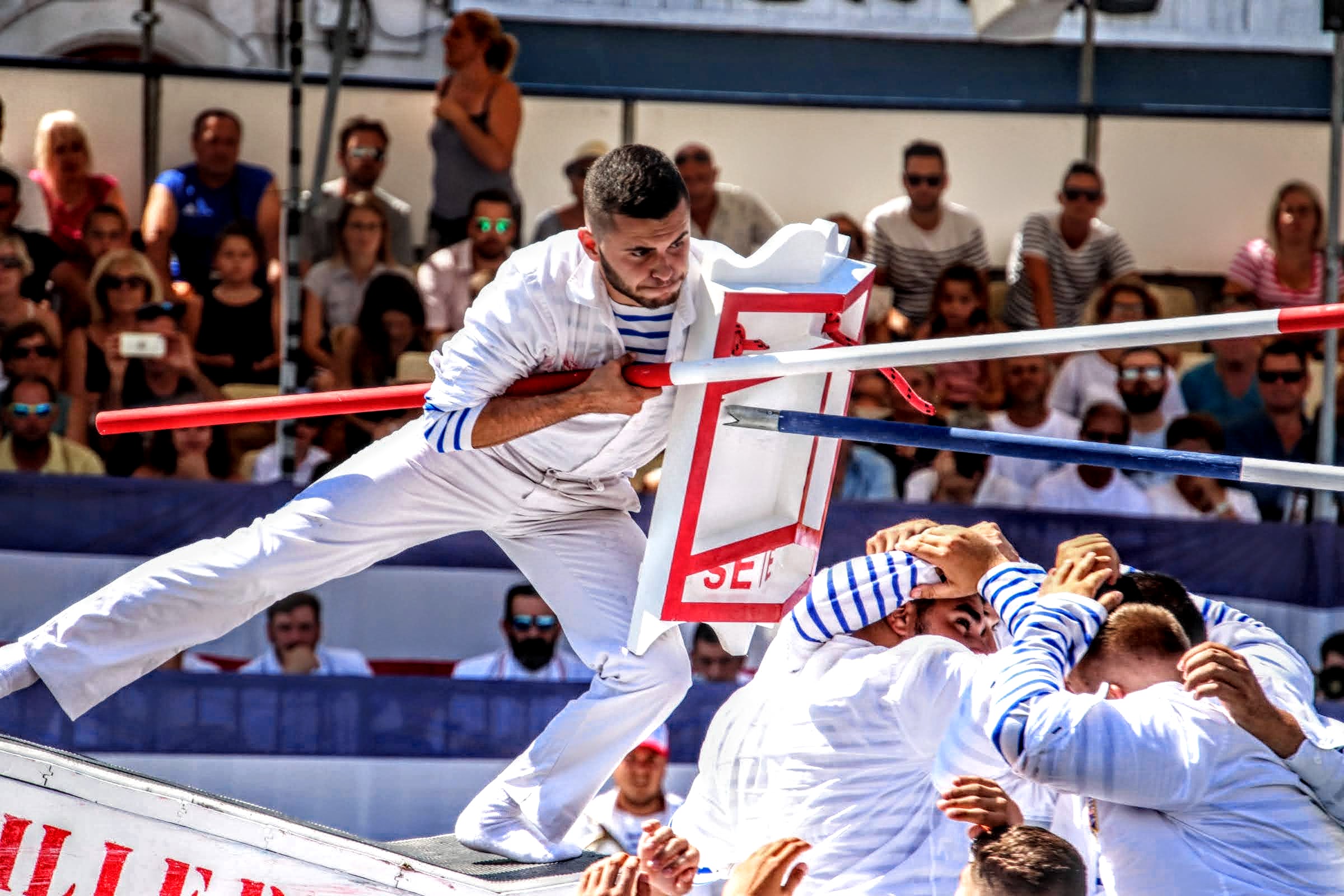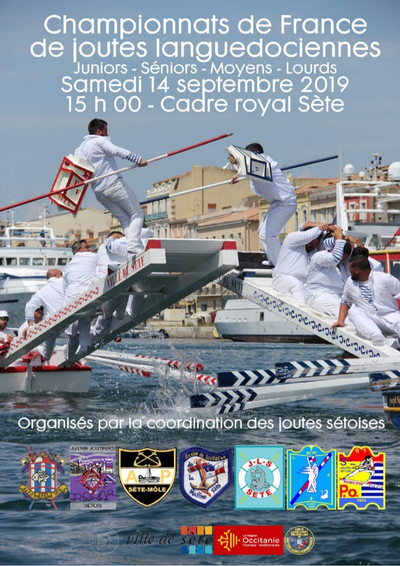
Joutes Languedociennes (France)
- Name of sport (game): Joutes languedociennes, joutes nautiques
- Name in native language: Joutes languedociennes
- Place of practice (continent, state, nation):
France, villes de l’Hérault et une ville du Gard.
Béziers, Agde, Marseillan, Mèze, Balaruc, Frontignan, Sète, Palavas, Le Grau-du-Roi. - History:
The history of the practice of jousting seems very old. Some representations attest to this as early as 2780 B.C. in the former Egyptian Empire. At this time, it is not a question of a playful or sporting practice, rather of quarrels settling on the water. Over time, the practice is found in Greece and then in Sicily; it is strongly diffused as a sport or show game under the Roman Empire (46 BC). Although they were certainly practiced, the nautical jousts reappear in the writings and representations only in the twelfth century after J-C, especially in Lyon in 1177. Nautical jousts flourished in the 16th century. At that time, they took place during performances in honour of dignitaries (king, queen, member of the court) or at major events, and were organized in the form of tournaments. Thus, the archives mention nautical joust tournaments on April 13, 1507 in Lyon, in honour of Queen Anne of Brittany, in 1536 in honour of Francis I and in 1548, for Henri II and Catherine de Medici. On September 13, 1782, in Lyon, a tournament of jousts broke a record of attendance (about 100,000 people attending).
In a few centuries, nautical jousts have become popular festivals very attractive. Nautical jousting was officially recognized as a sport in March 1960. Four years later, on November 22, the French Federation of Joute et Sauvetage Nautique (FFJSN) was born, the one recognized today since its approval in April 1971 by the Secretariat of Youth and Sports. The FFJSN currently has more than 81 joust companies, approximately 40 located along the Rhône.These companies are distinguished in four leagues: Ligue Languedoc, Ligue Nord de Loire Picardie, Ligue Rhône Alpes, Ligue Provence Alpes Côte d'Azur. This division is due to different methods of practicing nautical jousting, of which there are six: Provençal method, Languedoc method, Parisian method, Lyonnaise and Girondine method, Strasbourg method. - Description:
Two heavy boats, one red and the other blue, were propelled by eight to ten oarsmen and guided by two coxswains, the "helmsmen".
The gamers are positioned on a platform about three metres from the water at the end of each boat. This platform bears the name of tinaine. On the lower part of the tinaine, stand the jousts of the next duels.
The two boats then face each other, propelling each other until the final impact. At the time of the assault, the two boats graze on the right to allow the jousts to carry out "the pass". Equipped with their spear and a bulwark, the aim of the gamer is to bring down his opponent in the water. The winner is the one who stays in place on the tintaine after the pass. A player in position is slit-forward. It is a joust in force, especially as the gamer carries a heavy bulwark (shield) 70 cm high for 40 cm wide and a lance of 2.80 m with the other hand. Before 1920, the bulwarks were larger (20 cm larger) and heavier. A completely white outfit is mandatory for all gamers, as well as the wearing of socks, also white.
Music is omnipresent on the occasion of the Languedoc jousts. A pena is always in charge of punctuating the exploits of the gamers, while the rowers are entitled to two onboard musicians, a traditional Languedoc haubois and a drum (called tambornet), seated at the bow of each boat. They set the pace for the rowers. - Current status:
The Languedoc jousts have 17 societies of Jousts : L'Amicale des Pêcheurs Sète-Môle, L'Association des Jouteurs Biterrois, L'Avenir des Jouteurs Sétois, La Lance Sportive Sétoise, La Nouvelle Lance Mézoise, Le Pavois Agathois, La Jeune Lance Graulenne, La Jeune Lance Sétoise, La Jeune Lance Sportive Mézoise, La Société des Jouteurs Balarucois, La Société des Jouteurs Frontignanais, La Société des Jouteurs Sétois, La Lance Amicale Sétoise, La Lance Olympique Marseillanaise, La Lance Sportive Palavasienne, L'Amicale des Jouteurs de la Pointe-Short and The Society of Agathois Gamers.

- Importance (for practitioners, communities etc.):
The Languedoc method is one of five nautical joust variants recognized by the French Federation of Jousting and Nautical Life1.
This practice has been included in the Inventory of Intangible Cultural Heritage in France since 2012.
The queen event is the famous Grand Prix de la Saint-Louis in Sète around August 25 (the last Monday of August) (since 1743), but a points classification on the season (since 1962), a French championship (since 1927) and a Coupe de France (since 1963) also exist in four weight and age categories: Heavy, Medium, Senior and Junior. - Contacts:
Fédération Française de Joutes et Sauvetage Nautique
https://www.ffjsn.com/This email address is being protected from spambots. You need JavaScript enabled to view it.
https://www.facebook.com/ffjsnresultatsLigue Joutes Languedociennes
http://www.ligue-jouteslanguedociennes.com/ - Sources of information :
Books, articles:
Patrick Bertonèche, 1998, Joutes nautiques en France, Douarnenez, éd. le Chasse-Marée/Armen.
Jérôme Pruneau, 1998, « La sportivisation en marche dans les joutes languedociennes », in Bulletin de la Société d’Etudes Historiques et Scientifiques de Sète et sa Région, Frontignan : Soulié Imprimeur, 205-216.
Jérôme Pruneau & Charles Pigeassou, 1999, « La sportivisation dans les joutes languedociennes : de nouveaux repères », in L’Histoire du sport, l’histoire des sportifs, Paris, L’Harmattan, 385-399.
Jérôme Pruneau et Charles Pigeassou, 1999, « La sociabilité dans les sociétés de joutes languedociennes : phénoménologie du lien social », in L’Histoire du sport, l’histoire des sportifs, Paris : L’Harmattan, 373-384.
Jérôme Pruneau, 1998, « La sportivisation en marche dans les joutes languedociennes », in Bulletin de la Société d’Etudes Historiques et Scientifiques de Sète et sa Région, Frontignan : Soulié Imprimeur, 205-216.
Jérôme Pruneau, 1998, « Entre management théorique et application pratique : quelle place pour le management dans les organisations sportives traditionnelles ? L’exemple des joutes languedociennes », in Actes de colloque Premier Congrès de la Société Française de Management du Sport, Montpellier, 209-217.
Jérôme Pruneau et Charles Pigeassou, 1999, « Regards critiques sur les rites et rituels dans la joute languedocienne : tensions et médiation entre les différentes formes de caractérisation et d’interprétation des rites », in Corps et Culture rites et rituels dans le sport, 4, 64-86.
Jérôme Pruneau et Charles Pigeassou , 1998, « Regards sociologiques sur la dynamique du lien social dans les sociétés de joutes languedociennes », in Corps et Culture sport et lien social, 3, 173-190.
Jérôme Pruneau, 2000, « Les rites et rituels dans la joute languedocienne : une pierre angulaire entre tradition et modernité », in Sport et identité, Paris : L’Harmattan, 225-231.
Jérôme Pruneau, 2000, « Les joutes languedociennes », in Ethnosud, bulletin de liaison de l’A.R.C.E., n°16 janvier-mars.
Jérôme Pruneau, 1999-2000-2001, « De l’ancrage culturel a l’empreinte sportive : évolution du processus identitaire dans la joute languedocienne », in Revue Héraultaise, 30/31/32, 277-285.
Jérôme Pruneau, Les Joutes Languedociennes – Ethnologie d’un « sport traditionnel », Paris, L’Harmattan, coll. Espaces et temps du sport, 2003.
Jérôme Pruneau, « Le temps métissé des joutes languedociennes : un « entre-deux » révélateur » in Corps et Cultures, n° 6/7, 2004.
Jérôme Pruneau et Charles Pigeassou, 2004, « Du héros mythique au champion en titre : évolution et transformation du processus d’identification dans l’histoire des joutes languedociennes », in Delaplace J. M., Villaret S. et Chameyrat W., (Dir). Sport et Nature dans l’histoire – Sport and Nature in History – Sport und Natur im historischen, Academia Verlag, 33-43.
Jérôme Pruneau, 2009, « Les joutes nautiques en Languedoc-Roussillon. Trajectoire d’un jeu traditionnel, devenu « sport traditionnel »», revue des jeux Bretons.
Jérôme Pruneau, 2010. “Joutes nautiques”, in Le Dictionnaire culturel du sport sous la direction de Michael Attali et Jean St Martin, Paris : Armand Colin, 84-85
Jérôme Sagnard et Jean-Claude Caira, Les Joutes en France: l’âge d’or (1880-1920), Saint-Cyr-sur-Loire, éditions Alan Sutton, Mémoire du sport, 2008, 192 p.Articles:
https://www.lacomediedevanneau.com/joutes-languedociennes/
https://sauvetagegrigny.dudaone.com/newpage1Video:
https://www.youtube.com/watch?v=4Uag64-LYAA
https://www.youtube.com/watch?v=ND-o8SosqKo
https://www.youtube.com/watch?v=APd79jBhpXI
https://www.youtube.com/watch?v=5rS4VesHC58Photos: Guillaume Lanouhe (Association Brev’Art)
- Gallery:
- Documents:
 Cahier_des_charges_Barque_de_sauvetage.pdf
Cahier_des_charges_Barque_de_sauvetage.pdf FEDERATION_FRANCAISE_DE_JOUTES_ET_SAUVETAGE_NAUTIQUE-reglement-interieur-janvier2012-1.pdf
FEDERATION_FRANCAISE_DE_JOUTES_ET_SAUVETAGE_NAUTIQUE-reglement-interieur-janvier2012-1.pdf FFJSN_COMMISSION_NATIONALE_DES_ARBITRES.pdf
FFJSN_COMMISSION_NATIONALE_DES_ARBITRES.pdf FICHE_TYPE_DINVENTAIRE_DU_PATRIMOINE_CULTUREL_IMMATERIEL_DE_LA_FRANCE-Les_joutes_languedociennes.pdf
FICHE_TYPE_DINVENTAIRE_DU_PATRIMOINE_CULTUREL_IMMATERIEL_DE_LA_FRANCE-Les_joutes_languedociennes.pdf LIGUE_JOUTES_LANGUEDOCIENNES_RAME_TRADITIONNELLE_-_REGION_OCCITANIE_adresses-joutes.pdf
LIGUE_JOUTES_LANGUEDOCIENNES_RAME_TRADITIONNELLE_-_REGION_OCCITANIE_adresses-joutes.pdf LIGUE_JOUTES_LANGUEDOCIENNES_RAME_TRADITIONNELLE_-_REGION_OCCITANIE_adresses-joutes_1.pdf
LIGUE_JOUTES_LANGUEDOCIENNES_RAME_TRADITIONNELLE_-_REGION_OCCITANIE_adresses-joutes_1.pdf reglement_des_Ecoles_de_Joutes.pdf
reglement_des_Ecoles_de_Joutes.pdf REGLEMENT_METHODE_DE_JOUTES_LANGUEDOCIENNES.pdf
REGLEMENT_METHODE_DE_JOUTES_LANGUEDOCIENNES.pdf Rglements_Administratif_et_Technique_BARQUE_DE_SAUVETAGE.pdf
Rglements_Administratif_et_Technique_BARQUE_DE_SAUVETAGE.pdf Rglements_Administratif_et_Technique_Joute_Nautique_Mthode_Languedocienne.pdf
Rglements_Administratif_et_Technique_Joute_Nautique_Mthode_Languedocienne.pdf Rglements_Administratif_et_Technique_Rame_traditionnelle.pdf
Rglements_Administratif_et_Technique_Rame_traditionnelle.pdf

